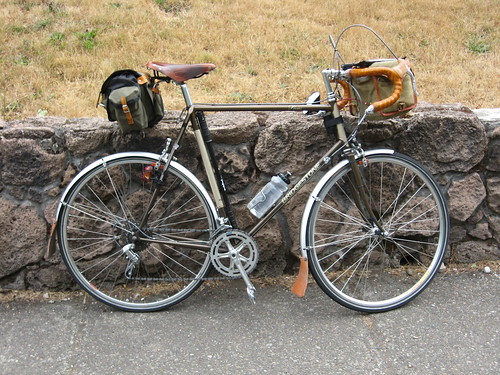To summarize his article in the Sunday NY Times today - it's been hard going so far. For better or worse, now many people can offer advice that is shared with all of us. The NY Times featured seven "emblematic" comments from the hundreds made so far, one of which suggests that it's his steel bike that's the problem.
I ride a lot. My best road bike cost $14,000 (custom full-carbon). I think you’re underserved by a steel bike. But then, I’m old (75), though I do log 5,000 miles per year cycling, in the U.S. and Europe.The suggestion seems to be that an expensive carbon fiber frame bike would be better for this activity than the (presumed not expensive) steel frame bike. I do not believe that it is necessary to spend anything like that much money on a bike suitable for this and I strongly believe most carbon fiber bikes would be a poor choice for what Mr. Weber is doing.

A steel randonneuring bike, based on a 1982 steel bike frame
Looking at the second issue first - I wonder if the writer understands what Mr. Weber is doing. If you are on a supported ride, when your baggage is carried by a support team in motor vehicles (and all the meals arranged in advance, and so on) then riding a carbon fiber road bike would be great. Here however the rider is carrying everything with him in panniers, and the traditional (and seemingly reasonable) approach to that is to ride a randonneuring or touring bicycle, made of steel. You sacrifice some weight for the cycle in favor of strength as well as a bicycle geometry more suitable for hauling weight long distances reliably and comfortably over pure speed. It's simple, really - touring bikes are made of steel. And this is a touring bike situation.
As to cost, that's a different matter - certainly one can spend thousands (even more than $15,000 for one custom built by a builder who produces them one at a time) on a high-end steel touring bike - I would chose something like this Co-Motion steel touring bike (at around $3,500). The example in the photograph (that could have a rack and panniers added easily enough) is based on a steel frame exactly like one I bought on eBay for $117 (including shipping!) that one could then kit out in a suitable way for another thousand dollars or so. I tend to think that Mr. Carbon-Fiber-is-Best is partially correct that for a bike to ride across America, Mr. Weber has underspent in dollars and is paying for it otherwise. And eventually will pay for various fixes such that it would have been less expensive to buy a more expensive - and suitable - bike right at the start. He has already replaced the cassette with one that has cogs more suitable for climbing hills at slow speed, for example. Many other components on a lesser bike will have a predictable service life less than the distance represented by a cross country ride.
I have not been able to work out exactly what sort of bike Mr. Weber is riding - the photos seem (purposely?) to obscure that information. The type of bike, however, is obvious enough - it is the kind of "not a mountain bike, not a road bike, but what is it bike" that one sees around town often enough. Riding across the country seems like an activity for a purpose-built bicycle.
No comments:
Post a Comment